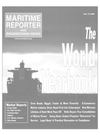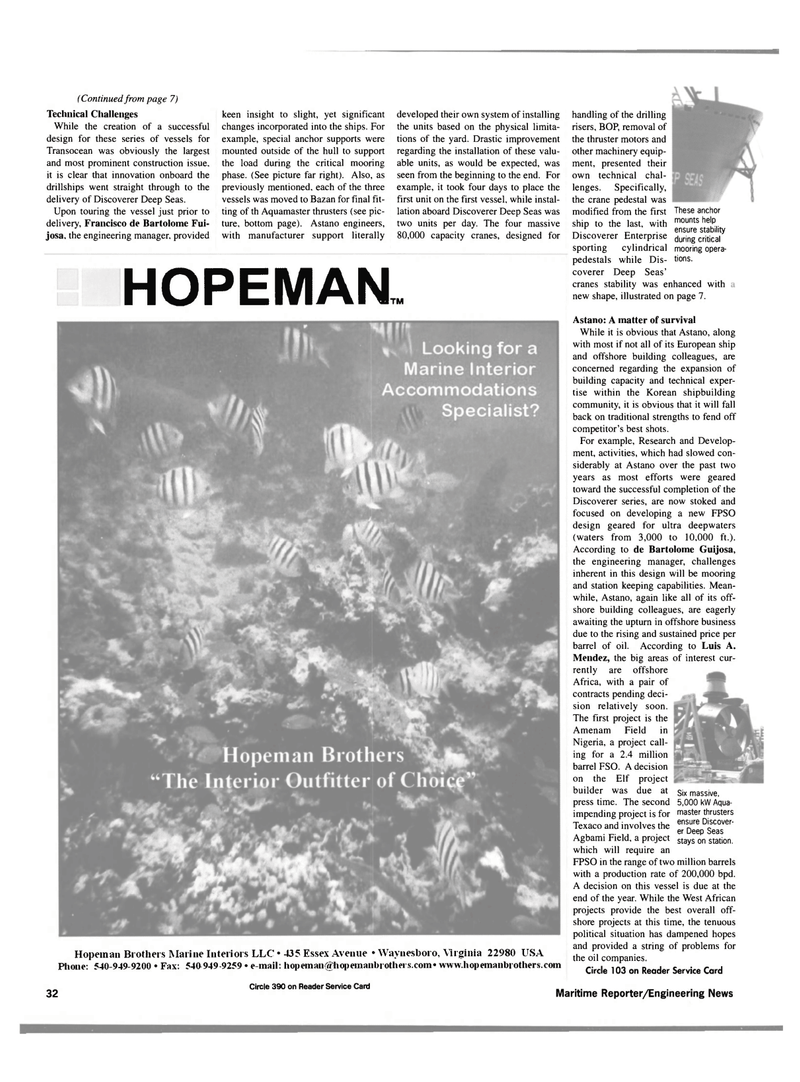
Page 36: of Maritime Reporter Magazine (June 15, 2000)
Read this page in Pdf, Flash or Html5 edition of June 15, 2000 Maritime Reporter Magazine
(Continued from page 7)
Technical Challenges
While the creation of a successful design for these series of vessels for
Transocean was obviously the largest and most prominent construction issue, it is clear that innovation onboard the drillships went straight through to the delivery of Discoverer Deep Seas.
Upon touring the vessel just prior to delivery, Francisco de Bartolome Fui- josa, the engineering manager, provided keen insight to slight, yet significant changes incorporated into the ships. For example, special anchor supports were mounted outside of the hull to support the load during the critical mooring phase. (See picture far right). Also, as previously mentioned, each of the three vessels was moved to Bazan for final fit- ting of th Aquamaster thrusters (see pic- ture, bottom page). Astano engineers, with manufacturer support literally developed their own system of installing the units based on the physical limita- tions of the yard. Drastic improvement regarding the installation of these valu- able units, as would be expected, was seen from the beginning to the end. For example, it took four days to place the first unit on the first vessel, while instal- lation aboard Discoverer Deep Seas was two units per day. The four massive 80,000 capacity cranes, designed for
HOPEMAIM.
Astano: A matter of survival
While it is obvious that Astano, along with most if not all of its European ship and offshore building colleagues, are concerned regarding the expansion of building capacity and technical exper- tise within the Korean shipbuilding community, it is obvious that it will fall back on traditional strengths to fend off competitor's best shots.
For example, Research and Develop- ment, activities, which had slowed con- siderably at Astano over the past two years as most efforts were geared toward the successful completion of the
Discoverer series, are now stoked and focused on developing a new FPSO design geared for ultra deepwaters (waters from 3,000 to 10,000 ft.).
According to de Bartolome Guijosa, the engineering manager, challenges inherent in this design will be mooring and station keeping capabilities. Mean- while, Astano, again like all of its off- shore building colleagues, are eagerly awaiting the upturn in offshore business due to the rising and sustained price per barrel of oil. According to Luis A.
Mendez, the big areas of interest cur- rently are offshore
Africa, with a pair of contracts pending deci- sion relatively soon.
The first project is the
Amenam Field in
Nigeria, a project call- ing for a 2.4 million barrel FSO. A decision the Elf project
Six massive, 5,000 kW Aqua- master thrusters ensure Discover- er Deep Seas stays on station.
Hopeman Brothers Marine Interiors LLC • 435 Essex Avenue • Waynesboro, Virginia 22980 USA
Phone: 540-949-9200 • Fax: 540949-9259 • e-mail: [email protected]* www.liopemanbrothers.com on builder was due at press time. The second impending project is for
Texaco and involves the
Agbami Field, a project which will require an
FPSO in the range of two million barrels with a production rate of 200,000 bpd.
A decision on this vessel is due at the end of the year. While the West African projects provide the best overall off- shore projects at this time, the tenuous political situation has dampened hopes and provided a string of problems for the oil companies.
Circle 103 on Reader Service Card 32
Circle 390 on Reader Service Card Maritime Reporter/Engineering News handling of the drilling risers, BOP, removal of the thruster motors and other machinery equip- ment, presented their own technical chal- lenges. Specifically, the crane pedestal was modified from the first ship to the last, with
Discoverer Enterprise sporting cylindrical pedestals while Dis- coverer Deep Seas' cranes stability was enhanced with new shape, illustrated on page 7.
These anchor mounts help ensure stability during critical mooring opera- tions.

 35
35

 37
37
